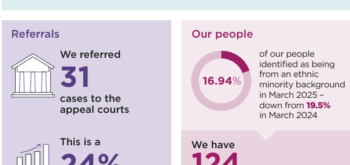News CPS guidance on joint enterprise ‘fails to get to grips’ with problem
New Crown Prosecution Service guidance has ‘completely failed to get to grips’ with joint enterprise, according to campaigners representing prisoners and their families. Following the publication of new principles on how to deal with the controversial common law doctrine back in July, the CPS launched a consultation which closed last week. The campaign group JENGbA (Joint Enterprise: Not Guilty by Association) has collated responses including submissions from 17 joint enterprise prisoners and calls on the director of public prosecutions to back their call for a public inquiry.
Under joint enterprise, a person on the fringes of a group in which somebody commits murder can receive the same mandatory life sentence as the perpetrator. In February 2016 in the landmark Jogee ruling, the Supreme Court held that the law had taken ‘a wrong turn in 1984‘.
The judgment did not end joint enterprise – and the first tranche of post-Jogee appeals were all rejected in October last year (here) – however the Supreme Court sought to return the law to its pre-1984 position. For a secondary party to be found guilty of a crime, they would have to have ‘intentionally assisted or encouraged’ the crime rather than merely having had some ‘foresight’ that the crime might take place.
In a letter to the DPP Alison Saunders, JENGbA argues the new guidance in ‘no way ensures that miscarriages of justice will not continue in the future’. ‘The guidelines completely fail to get to grips with the strong message from the Court of Appeal back in February 2016,’ commented JENGbA’s campaign co-ordinator. ‘The relabelling of “joint enterprise” as “accessorial liability” is, at best, unhelpful and, at worst a rather disingenuous attempt to undermine the gathering momentum of a campaign to properly reform the law. It won’t work.’
Last month the Lammy review into race and the criminal justice system called for a new approach to joint enterprise and gang prosecutions. According to the report, up to half of those convicted under the common law doctrine of joint enterprise were from Black and Minority Ethnic backgrounds as were almost nine out of 10 of the 3,621 names on the Metropolitan Police’s database of gang names.
JENGbA reports that many of the prisoners who responded to the CPS consultation, despite being convicted under the doctrine, still found it ‘very confusing to understand what secondary liability means’ and many had ‘not understood what joint enterprise meant during their trial’. ‘Since it has now been established by the Supreme Court that the “law” was wrong, we argue that those convicted under the law which was being misapplied were not given a fair trial, juries would have been wrongly directed by judges under a misdirection of law, and prosecutors were basing their cases on flimsy evidence such as foresight,’ JENGbA’s Gloria Morrison wrote in a letter to Saunders.
The new guidance acknowledges that Jogee rejects the concept of parasitic accessory liability – in other words, where X and Y participate together in one crime and in the course of the crime X commits a second crime which Y had foreseen he might commit. Throughout the document, ‘joint enterprise’ is referred to with the new name of ‘accessorial liability’.

The JENGbA families at the Jogee ruling in the Supreme Court in February 2016
JENGbA argues that the relabelling ‘negates’ work by the campaign for the last seven years. ‘By removing the terminology of the doctrine it is suggesting that this massive problem has gone away,’ she wrote; adding that the CPS guidance maintained that a defendant’s mere presence at the scene can be sufficient support for a conviction.
Prisoners complained in their response to the CPS consultation that little substantive change had been made. One prisoner currently serving a sentence at HMP Leyhill wrote: ‘It still pretty much reads to me that if the principal offender commits a crime then the secondary party can still be charged with the same offence.’
‘They have been convicting innocent people. They really need to sort out the past 30 years of mistakes as a matter of urgency. They have ruined enough people’s lives, shown no remorse for their abuse of the law and not even attempted to take responsibility for their actions.’
Prisoner at at HMP Leyhill
Charlotte Henry, a lawyer whose brother Alex was convicted for joint enterprise, criticised the introduction of the concept of ‘conditional intent’. The CPS explains that if two or more defendants have a common purpose to commit one crime (for instance, a drug deal), then all those party to the original crime may have offered the ‘necessary conditional intent’ for the committal of a second and more serious crime (such as homicide). ‘The guidance does not clarify the degree of foresight required,’ argued Henry, judging that ‘the section on conditional intent does not accurately reflect the law as it stands’.
Concerns also remain that the new guidance does nothing to reduce the likelihood that joint enterprise will disproportionately affect young BAME men as highlighted by the Lammy review.
Becky Clarke and Patrick Williams, academics at Manchester Metropolitan University’s Sociology Department, maintained that ‘the terminology of the “gang” is writ large’ across the CPS document, ‘suggesting that the guidance has been written with a direct intention of establishing a particular approach to punishment for groups or gangs. The use of this language will arguably provoke its disproportionate use against young BAME men.’
Responding to the guidance, Felicity Gerry QC who represented Ameen Jogee, delivered a similar message. ‘There should be no assumption that the group is a gang. Non-prosecution or choice of a lesser offence should flow where it is obvious that a child has been led into offending by others or it is a case of a protest affected by the actions of a few.’
The Lammy review noted that post-Jogee experts remained concerned about joint enterprise. ‘The CPS should take the opportunity, while it reworks its guidance on Joint Enterprise, to consider its approach to gang prosecutions in general,’ it said.
These conclusions were shared by many of the prisoners. ‘As for this “new” guidance,’ wrote a male prisoner at HMP Frankland, ‘it appears to carry similar “flaws” and “pitfalls” as to that of pre-Jogee. This will be a matter for our lawyers to challenge.’
Another prisoner at HMP Whitemoor argued that ‘the latest CPS document only adds to the mix of confusion’, claiming that the current position was unclear. ‘I believe that a further visit to the Supreme Court will become necessary so as to set down a workable and fair boundary between Jogee and all subsequent authority,’ he said.







